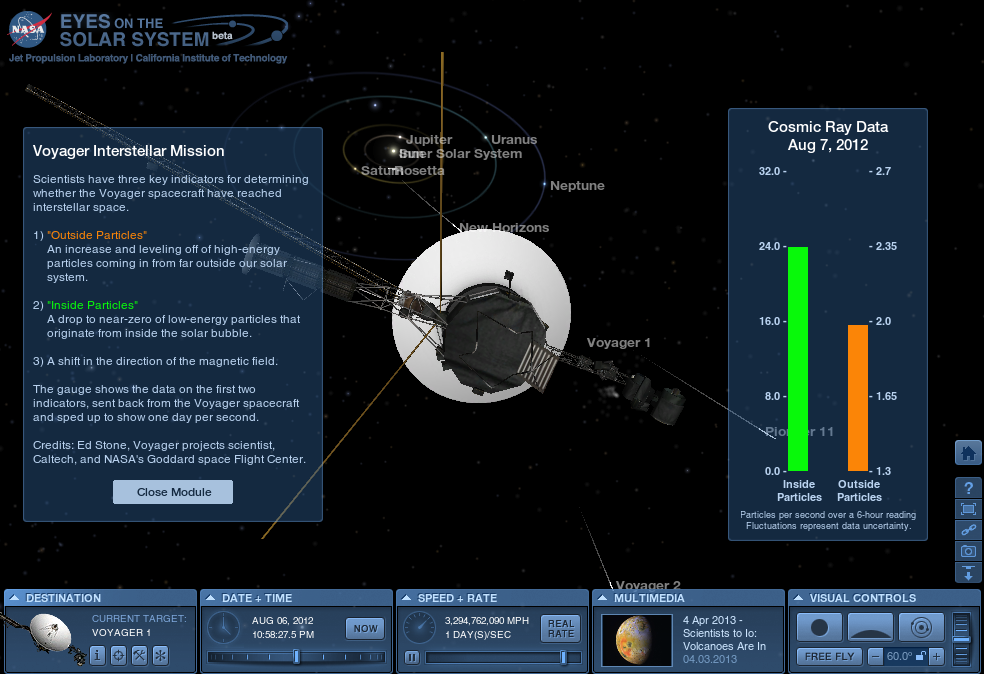The history of spaceflight is filled with great images, such as Neil Armstrong setting foot on the Moon or Viking 1’s first images from Mars, but some of the most dramatic events haven’t any images to accompany them. As NASA's two Voyager spacecraft leave the Solar System, there won’t be any historic pictures sent back. Instead, that invisible boundary between our system and interstellar space will be marked by readings taken by the instruments of the spacecraft. NASA has placed a readout on the Voyager mission home page that shows two of three key factors that will let the public know when this momentous milestone has been reached.
Voyager 1 and Voyager 2 are deep-space probes launched in 1977 by NASA to study the outer planets and the frontiers of the Solar System. The 722 kg (1,590 lb) spacecraft are powered by three radiothermal generators. In 1979, they flew by Jupiter and in 1980 Voyager 1 visited Saturn, with Voyager 2 flying by in 1981. While Voyager 1 headed toward interstellar space at a greater speed than Voyager 2, the latter flew by Uranus in 1986 and Neptune in 1989 before it also ended up on a trajectory out of the Solar System. Voyager 1 is now so distant that a radio message from Earth takes 17 hours to reach it. A transmission from Voyager 2, on the other hand would take “only” 14 hours.

Both Voyager 1 and 2 are well beyond the solar orbit of any planetary bodies, but according to scientists the Solar System extends even to that tremendous distance. For astronomers, the Solar System’s boundary is the point where the Sun is no longer able to push out the incredibly tenuous bubble of gas that surrounds it called the heliosphere and where its magnetic field no longer dominates.
What NASA scientists are looking for is a shift between three factors that the two Voyagers are measuring with their onboard instruments. One is Anomalous Cosmic Rays (ACR), which are cosmic ray particles that have become trapped by the Sun’s magnetic field. The second is Galactic Cosmic Rays (GCR), which are cosmic rays from outside the Solar System, and the third is the direction of the Sun’s magnetic field.
The first thing that the scientists are looking for is when the ACR readings suddenly start to plummet and the GCR readings start to climb at the same time. What this means is that the Sun’s forces that are holding in most of the ACRs and keeping out most of the GCRs have reached their limit. The majority of cosmic ray particles from inside the Solar System can’t reach Voyager, but the ones from outside now have a much better chance.

However, this still isn't considered the outer limit of the Solar System. Instead, it’s what’s called the “magnetic highway," which Voyager 1 is currently traversing. What NASA is waiting for is the moment when Voyager 1 sees a change in the direction of the Sun’s magnetic field. It’s at this point that the probe moves from the heliosphere and into interstellar space.
The readout on the Voyager mission home page shows the ACR and GCR (also called Inside Particles and Outside Particles, respectively) and is updated every six hours. When a Voyager probe moves into the magnetic highway, the relative sizes of the bars reverse, as has happened with Voyager 1’s. However, the readout doesn’t track the magnetic field direction because this is a more complex phenomenon that will require analysis before a determination can be made.
In addition to the home page, the readout is also available as a module on NASA’s Eyes on the Solar System tool. This game-like browser app allows visitors to tour the Solar System in a virtual environment as well as ride along with the Voyager 1 probe on its historic journey.
Source: NASA























